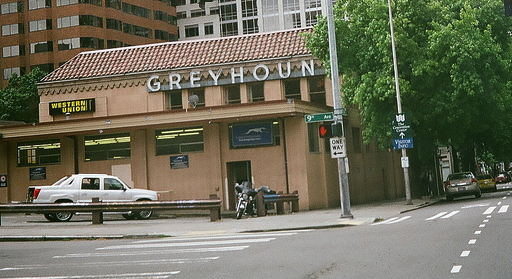PMother for you I made this
Various downtown locations; reservations required. 351-3238, velocitydancecenter.org. $12–$18. 8 p.m. Wed.–Sun. Ends May 19.
Ezra Dickinson’s new solo piece deals with some very dark subjects—his mother’s ongoing struggle with schizophrenia and the phone call when she told him she was living on the street. But it does so with such powerful sweetness that we are beguiled as well as saddened.
Raised in Bellingham, Dickinson would come to Seattle on the Greyhound bus to take classes at Pacific Northwest Ballet, and the now-boarded-up bus station is where we first see him, from a vantage point across the street. Mother for you I made this is a collection of vignettes, danced in public spaces downtown. We hear the score over headphones, a combination of natural sounds, text, and music by Paurl Walsh, broadcast from a purple rolling suitcase. We trail behind that piece of luggage through sidewalks, parking lots, alleys, and parks, as Dickinson dances in the kind of street environments where he envisions his mother having lived. He is a quixotic Pied Piper, and we are his willing followers.
Alongside his PNB training, Dickinson has a wide-ranging dance background, and much of it is on display here. A beautifully lofted balletic assemble lands him at a street corner. Down the block, he weaves a long banner around a collection of birch trees like a shaman in a public park. We stop in the middle of an alley to watch a video: Dickinson and an eclectic group of dancers kicking trash like soccer balls, skittering around inside a chain-link fence, sneaking into a boarded-up building.
Throughout the work he’s asking questions, of himself and of us, about our responsibilities to our families and to people in general: “Who will make a home for my mother? We have forgotten our loved ones.” As Dickinson takes us on a tour of life on the streets, we start to notice other pedestrians who are watching, and we wonder if any of them live in the spaces we’re just visiting. We look at the whole of the environment with the same attention we bring to the theater; we also see ourselves reflected in the windows of a passing bus.
The performance ends in a plaza near the bus station with a dance using a full-head, papiermache dinosaur mask—the kind of fantastical play toy that his mother taught him to make. Perhaps because Dickinson identified himself as his mother’s son, we see him at least partially as a child, and that childhood acts as a protective buffer. When he curls up under a little patchwork blanket, it’s both charming and disturbing—a reminder that a childhood quilt won’t keep the rain out. SANDRA KURTZ
E
stage@seattleweekly.com




